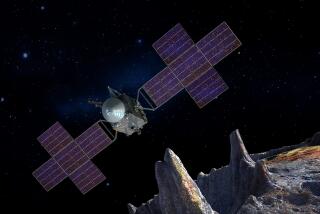Local Hands on a New Space Project
- Share via
Crystal capsules prepared by UC Irvine scientist Alexander McPherson and schoolchildren across the United States are scheduled to be launched into space this morning on the shuttle Atlantis, destined for the International Space Station, a gigantic laboratory taking shape about 200 miles above Earth.
The space station is a 16-nation effort led by the U.S. that should be completed in 2005. The finished lab, which will house scientists, should be as big as a football field and would weigh 1 million pounds on the ground.
The growing of protein crystals is the first experiment aboard the massive lab. Protein crystals, used for new HIV inhibitors, cancer drugs, nonpolluting laundry detergent and more, grow better in the low-gravity environment of space.
About 150 of the 500 crystal samples being sent up were made by students in California, Alabama, Florida and Tennessee. A total of 87 California students and teachers participated, most in Los Angeles and Orange counties.
“Our intention is not just to use the space station as a lab, but as a scientific classroom for the United States,” McPherson said.
McPherson said student participation is a key element, because today’s students are tomorrow’s scientists. He traces his own interest in science to his youth.
A Mission to Excite Kids About Science
“Since I grew up in Orlando, I saw all the early missions. I’ve been following the space program since Alan Shepard went up in the early 1960s,” he said.
But today, “the students are simply not going into science and mathematics--they think it’s too hard or intimidating or not interesting,” he said. “We’re trying to turn that around. Science is the most interesting thing in the world.”
Researchers and the students, working under McPherson’s direction, sealed chemicals into small tubes that were then frozen to minus-320 degrees Fahrenheit. Scientists placed the samples into thermos-like containers that are kept cool with liquid nitrogen. Once in orbit, the nitrogen naturally boils off, thawing the samples and allowing the protein crystals to begin growing, according to the National Aeronautics and Space Administration.
The crystals will remain in orbit until October, when they will be retrieved by another manned space shuttle.
Once the crystals are brought back to Earth, scientists will use X-rays to deduce the detailed atomic structure of the molecules.
Such studies have significant implications for humans because information gathered from the crystals can ultimately be used for manufacturing pharmaceuticals, and to learn more about human ailments such as genetic defects.
“Those protein molecules are extremely important because they are the major biochemical element of all living tissue,” said McPherson, who has been involved with NASA protein crystal projects since 1984. He received the agency’s Exceptional Scientific Achievement Medal in 1999. “We can use our knowledge of those to design new drugs.”
The information also has applications in the manufacturing of insecticides, herbicides and industrial products, such as laundry detergents that use enzymes.
(BEGIN TEXT OF INFOBOX / INFOGRAPHIC)
Crystal Clear
Crystals grow more uniformly in the low-gravity environment of space, making them easier to study back on Earth. Specimens due to be launched in the space shuttle Atlantis today will be studied by scientists when they are returned in October.
*
With Gravity
On Earth, the molecular structure of the protiens in the crystals are imprecise and more difficult to decipher.
*
Without Gravity
In space, the molecular structure of protiens is more precise and easier to decipher.
*
Graphics reporting by BRADY MacDONALD / Los Angeles Times
Source: Stan Koszelak, UCI researcher







